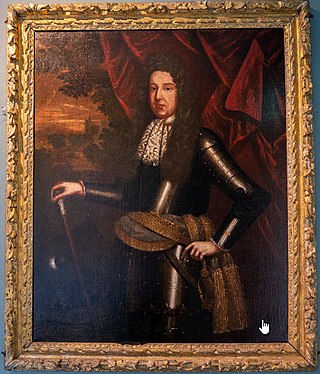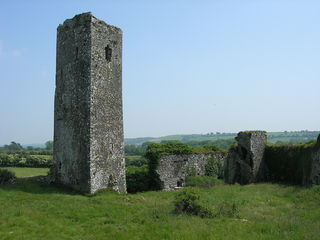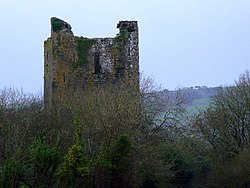
Macroom is a market town in County Cork, Ireland, located in the valley of the River Sullane, halfway between Cork city and Killarney. Its population has grown and receded over the centuries as it went through periods of war, famine and workhouses, forced emigration and intermittent prosperity. The 2011 census gave an urban population of 3,879 people, while the 2016 census recorded 3,765 people.

The Kingdom of Desmond was a historic kingdom in southwestern Ireland. It was founded in 1118 by Tadhg Mac Cárthaigh, King of Munster when the Treaty of Glanmire formally divided the Kingdom of Munster into Desmond and Thomond. It comprised all of what is now County Cork and most of County Kerry. Desmond was ruled by the Mac Cárthaigh (MacCarthy) dynasty. Other clans within the kingdom included the O'Sullivans and O'Donovans. Following the Norman invasion of Ireland in the late 12th century, the eastern half of Desmond was conquered by the Anglo-Normans and became the Earldom of Desmond, ruled by the Fitzmaurices and FitzGeralds—the famous Irish family known as the Geraldines. The king of Desmond, Diarmaid Mac Cárthaigh submitted to Henry II of England, but the western half of Desmond lived on as a semi-independent Gaelic kingdom. It was often at war with the Anglo-Normans. Fínghin Mac Carthaigh's victory over the Anglo-Normans at the Battle of Callann (1261) helped preserve Desmond's independence. The kings of Desmond founded sites such as Blarney Castle, Ballycarbery Castle, Muckross Abbey and Kilcrea Friary. Following the Nine Years' War of the 1590s, Desmond became part of the Kingdom of Ireland.

Blarney Castle is a medieval stronghold in Blarney, near Cork, Ireland. Though earlier fortifications were built on the same spot, the current keep was built by the MacCarthy of Muskerry dynasty, a cadet branch of the Kings of Desmond, and dates from 1446. The Blarney Stone is among the machicolations of the castle.

Kilcrea Friary is a ruined medieval abbey located near Ovens, County Cork, Ireland. Both the friary and Kilcrea Castle, located in ruin to the west, were built by Observant Franciscans in the mid 15th century under the invitation of Cormac Láidir MacCarthy, Lord of Muskerry, as protection from English troops.

MacCarthy, also spelled Macarthy, McCarthy or McCarty, is an Irish clan originating from Munster, an area they ruled during the Middle Ages. It was divided into several septs (branches) of which the MacCarthy Reagh, MacCarthy of Muskerry, and MacCarthy of Duhallow were the most notable.

Sir Donough MacCarty, 1st Earl of Clancarty (1594–1665), was an Irish soldier and politician. He succeeded his father as 2nd Viscount Muskerry in 1641. He rebelled against the government and joined the Irish Catholic Confederation, demanding religious freedom as a Catholic and defending the rights of the Gaelic nobility. Later, he supported the King against his Parliamentarian enemies during the Cromwellian conquest of Ireland.

Charles MacCarty, Viscount Muskerry, called Cormac in Irish, commanded a royalist battalion at the Battle of the Dunes during the interregnum. He was heir apparent to Donough MacCarty, 1st Earl of Clancarty but was killed at the age of 31 at the Battle of Lowestoft, a sea-fight against the Dutch, during the Second Anglo-Dutch War, and thus never succeeded to the earldom. He was buried in Westminster Abbey.

Carrigaphooca Castle is a ruined five storey rectangular tower house situated on a steep-sided rock overlooking the River Sullane. It is located 6 km west of Macroom, County Cork, Ireland, in an area once known as Gleann na n-Dearg. The tower dominates the landscape of Lissacresig (Fairyland) in Clondrohid, and Lower Shanballyshane, in Kilnamartyra. Carrigaphooca is made of sandstone and limestone and was built as a defensive tower by the MacCarthys of Muskerry in the early 15th century.

Ballincollig Castle is a Norman castle to the south of the town of Ballincollig, County Cork, Ireland, built after the Norman invasion of Ireland. In its prime, the castle was inhabited by the Barrett family, who had control of the local area. The castle still stands today, albeit largely in ruin. The original keep still remains, as does most of the curtain wall and two towers.
Thomas O'Herlahy was the Catholic Bishop of Ross, Ireland (Rosscarbery).

Farran is a village in County Cork, Ireland, in the parish of Ovens. It lies on the southside of the River Lee. Farran is 12 miles (19 km) west from Cork City on the N22 road.
Cormac Laidir MacCarthy, 9th Lord of Muskerry (1411–1494), was an Irish chieftain. He founded Kilcrea Friary and built Kilcrea Castle.

The MacCarthy dynasty of Muskerry is a tacksman branch of the MacCarthy Mor dynasty, the Kings of Desmond.

Carrignamuck Tower House, located in Carrignamuck townland, is a 15th century tower house located 2.8 km (1.7 mi) north of Coachford village and 2 km (1.2 mi) north-west of Dripsey village. It is also sometimes known as 'Dripsey Castle', a name latterly attributed to the 18th century house, Dripsey Castle, built nearby.

Dripsey Castle is a country house in the townland of Carrignamuck, situated 3.3 km (2.1 mi) north-east of Coachford village and 2.5 km (1.6 mi) north-west of Dripsey village. The house and demesne were dominant features in the rural landscape of Ireland, throughout the eighteenth and nineteenth centuries. Location often reflected the distribution of better land, and this is evidenced in mid-Cork, where many of these houses are situated along the valley of the River Lee and its tributaries.

Carrignamuck is a townland within the civil parish of Magourney and catholic parish of Aghabullogue, County Cork, Ireland. It is 363.76 acres in size, situate north-east of Coachford village, and north-west of Dripsey village.

Macroom Castle, in the centre of the town of Macroom, was once residence and fortress of the Lords of Muskerry. The castle has changed owners many times, has been besieged, burned, and rebuilt. The MacCarthys of Muskerry owned it with some interruptions from about 1353 when Muskerry was given to Dermot MacCarthy, 1st Lord of Muskerry, until 1691 when Donogh MacCarthy, 4th Earl of Clancarty lost it definitively.

Togher Castle, is a late 16th century tower house primarily known for its association with the MacCarthys of Gleannacroim. It is located approximately 9 kilometres (5.6 mi) north of the town of Dunmanway in the townland of Togher, which derives from the Irish "tóchar" meaning "causeway", or "causeway of wood over a bog".

Cormac MacDermot MacCarthy, 16th Lord of Muskerry (1552–1616) was an Irish magnate and soldier. He fought at the Siege of Kinsale during Tyrone's Rebellion.

Cormac Oge Laidir MacCarthy, 10th Lord of Muskerry (1447–1536) was an Irish chieftain, styled Lord of Muskerry. In 1520 he defeated James FitzGerald, 10th Earl of Desmond in the battle of Mourne Abbey.
















